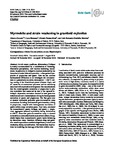Myrmekite and strain weakening in granitoid mylonites
| dc.contributor.author | Ceccato, A | |
| dc.contributor.author | Menegon, Luca | |
| dc.contributor.author | Pennacchioni, G | |
| dc.contributor.author | Morales, LFG | |
| dc.date.accessioned | 2018-12-10T12:32:36Z | |
| dc.date.issued | 2018-12-10 | |
| dc.identifier.issn | 1869-9529 | |
| dc.identifier.issn | 1869-9529 | |
| dc.identifier.uri | http://hdl.handle.net/10026.1/13008 | |
| dc.description.abstract |
At mid-crustal conditions, deformation of feldspar is mainly accommodated by a combination of fracturing, dissolution–precipitation, and reaction-weakening mechanisms. In particular, K-feldspar is reaction-weakened by the formation of strain-induced myrmekite – a fine-grained symplectite of plagioclase and quartz. Here we use electron backscattered diffraction to (i) investigate the microstructure of a granodiorite mylonite, developed at ∼ 450 °C during cooling of the Rieserferner pluton (Eastern Alps); and (ii) assess the microstructural processes and the weakening associated with myrmekite development. Our analysis shows that the crystallographic orientation of plagioclase in pristine myrmekite was controlled by that of the replaced K-feldspar. Myrmekite nucleation resulted in both grain-size reduction and anti-clustered phase mixing by heterogeneous nucleation of quartz and plagioclase. The fine grain size of sheared myrmekite promoted grain-size-sensitive creep mechanisms including fluid-assisted grain boundary sliding in plagioclase, coupled with heterogeneous nucleation of quartz within creep cavitation pores. Flow laws, calculated for monomineralic quartz, feldspar, and quartz + plagioclase aggregates (sheared myrmekite) during deformation at 450 °C, show that grain-size-sensitive creep in sheared myrmekite accommodated strain rates several orders of magnitude higher than monomineralic quartz layers deforming by dislocation creep. Therefore, diffusion creep and grain-size-sensitive processes contributed significantly to bulk rock weakening during mylonitization. Our results have implications for modelling the rheology of the felsic middle crust. | |
| dc.format.extent | 1399-1419 | |
| dc.language | en | |
| dc.language.iso | en | |
| dc.publisher | European Geosciences Union | |
| dc.title | Myrmekite and strain weakening in granitoid mylonites | |
| dc.type | journal-article | |
| dc.type | Journal Article | |
| plymouth.author-url | https://www.webofscience.com/api/gateway?GWVersion=2&SrcApp=PARTNER_APP&SrcAuth=LinksAMR&KeyUT=WOS:000452664400001&DestLinkType=FullRecord&DestApp=ALL_WOS&UsrCustomerID=11bb513d99f797142bcfeffcc58ea008 | |
| plymouth.issue | 6 | |
| plymouth.volume | 9 | |
| plymouth.publication-status | Published online | |
| plymouth.journal | Solid Earth and Discussions | |
| dc.identifier.doi | 10.5194/se-9-1399-2018 | |
| plymouth.organisational-group | /Plymouth | |
| plymouth.organisational-group | /Plymouth/Faculty of Science and Engineering | |
| plymouth.organisational-group | /Plymouth/REF 2021 Researchers by UoA | |
| plymouth.organisational-group | /Plymouth/REF 2021 Researchers by UoA/UoA07 Earth Systems and Environmental Sciences | |
| dcterms.dateAccepted | 2018-11-29 | |
| dc.rights.embargodate | 2018-12-19 | |
| dc.identifier.eissn | 1869-9529 | |
| dc.rights.embargoperiod | Not known | |
| rioxxterms.versionofrecord | 10.5194/se-9-1399-2018 | |
| rioxxterms.licenseref.uri | http://www.rioxx.net/licenses/all-rights-reserved | |
| rioxxterms.type | Journal Article/Review |


